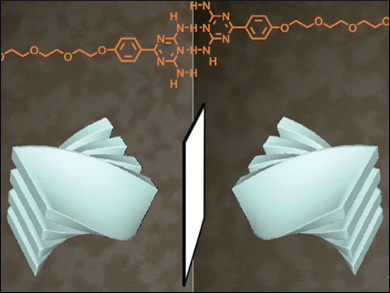Chirality is a unique signature of living matter, but the origin of spontaneous symmetry breaking in prebiotic aqueous fluids is still a matter of debate. Carsten Tschierske, Martin-Luther-University Halle-Wittenberg, Halle/Saale, Germany, and colleagues developed and investigated amino-substituted nitrogen heterocycles with a polar flexible chain, which can undergo self-assembly.
The researchers found that the compounds form an optically isotropic mesophase composed of chiral domains with an opposite sense of chirality, even though the components themselves are achiral. The symmetry breaking results from the helical deformation of bilayer ribbon segments, which are composed of hydrogen-bonded dimeric aggregates. This deformation causes a helical twist.
The results show that spontaneous macroscopic desymmetrization of simple hydrogen-bonded heterocycles, which bear structural similarities to biologically relevant nucleobases, could be a route to homochirality in prebiotic fluid systems.
- Chirality Synchronization of Hydrogen-Bonded Complexes of Achiral N-Heterocycles,
Jens Buchs, Laura Vogel, Dietmar Janietz, Marko Prehm, Carsten Tschierske,
Angew. Chem. Int. Ed. 2016.
DOI: 10.1002/anie.201609252




